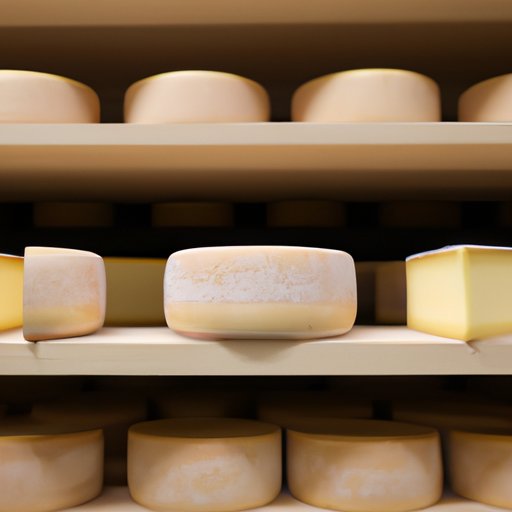
Introduction
As cheese lovers, we all know the importance of storing cheese in the right way. Proper storage techniques can significantly enhance the flavor and texture of cheese. On the other hand, improper storage can lead to spoilage and waste. In this article, we will explore the best practices for storing different kinds of cheese, including the effects of temperature, humidity, and storage methods on shelf life and quality. We will also provide tricks, tips, and common pitfalls of cheese storage for you to get the most out of your cheese collection.
The Importance of Proper Cheese Storage
Cheese is a delicate food that can easily spoil, and there are many factors that can impact its shelf life and quality. Temperature and humidity are the most important factors to consider when storing cheese. Cheese needs to be stored at a consistent temperature, typically between 35-45°F. Cheese can absorb strong odors in your fridge, so store it in an airtight container or wrap it tightly in plastic wrap or cheese paper. Additionally, the type of cheese and its level of moisture can impact its shelf life and texture.
From Fridge to Freezer: Exploring Different Storage Options for Different Types of Cheese
Each type of cheese requires specific storage conditions to optimize shelf life and flavor. Most fresh cheese, like ricotta and feta, should be stored in a brine solution to maintain their texture and moisture content, while aged cheese like cheddar or gouda can be stored wrapped tightly in plastic wrap or cheese paper. Additionally, some cheese varieties like brie or camembert require specific humidity levels to ripen properly. As for freezing cheese, only some aged hard cheese varieties are suitable for freezing while the high-moisture soft cheese is not. The texture of cheese can change when it’s thawed; so freezing cheesing should be resorted to as a last option.
Cheese Storage Hacks: Clever Tricks for Maximizing Shelf Life and Preventing Spoilage
There are clever ways of storing cheese to extend its shelf life and prevent spoilage. One way to do this is by wrapping cheese in cheese papers or wax. Cheese papers are designed to help regulate humidity and provide a comfortable environment for cheese to thrive, and wax coating can help prevent mold growth. Another great trick for preserving cheese is vacuum sealing, which helps to prevent the entry of air and prolongs the shelf life of cheese. Furthermore, you can prevent molds from growing on the surface of cheese by brushing a thin layer of vinegar or olive oil on it and storing it wrapped tightly or in an airtight container in the refrigerator.
Aging Gracefully: How to Store Artisanal Cheese to Enhance Its Flavor and Texture
Artisanal cheese is produced in small batches and is aged to enhance its flavor and texture. Typically, artisanal cheese is stored at low temperatures with moderate humidity, allowing them to reach optimal ripeness. When selecting artisanal cheese, it’s best to look for cheese with natural rinds and avoid cheese with visible surface mold to minimize spoilage risks. Artisanal cheese can be kept safely and without any adverse effects on flavor or texture for long periods if stored correctly.
The Dos and Don’ts of Cheese Storage: Common Mistakes and How to Avoid Them
There are some common mistakes that people make when it comes to cheese storage, which can impact the aroma and flavor of cheese, particularly when it comes to soft cheese varieties. Do not store cheese in the fridge in a cling-film or plastic bags as this can inhibit airflow and trap moisture. Do not store cheese too long without taking off the plastic or wax coating first, as this can create undesirable flavors. Always make sure that the cheese is loosely wrapped when stored in the fridge, particularly if it has a strong aroma. To avoid these mistakes, store your cheese whole and remove the rind just before consuming it.
The Perfect Pairing: Matching Cheese Storage Strategies with Your Favorite Wine and Accompaniments
When it comes to pairing cheese with wine, matching the right storage environment with your favorite wine can enhance the tasting experience. Cheese stored at a cold temperature can mute subtle flavors, while higher humidity can exacerbate the flavor profile. Cheese with strong flavors, such as a sharp cheddar, pairs well with robust red wine like Cabernet Sauvignon, while delicate white wine pairs well with brie or camembert cheese. From cheese plates to cheese masks; ideal cheese pairings are subjective and fun to experiment with.
Conclusion
The quality of cheese largely depends on how you store and care for it. Whether it’s simple wrapping or storing it in a cheese paper, avoiding common storage mistakes or selecting the right cheese to age. Proper cheese storage can prevent waste, enhance the flavor, and extend the shelf life of your cheese. Now you know how to store cheese to maintain its quality, and hopefully, your next cheese platter will be a treat for your taste buds.




